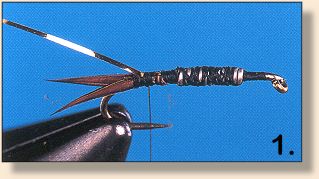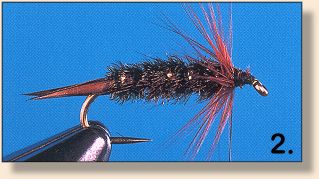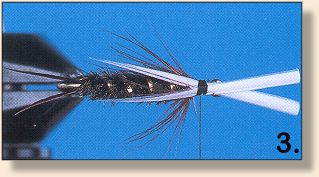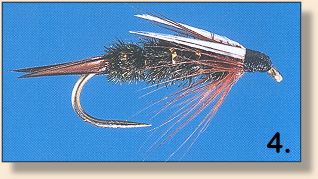Prince Nymph
Text and photos by Jim Schollmeyer
Peacock bodies flies have long been a favorite of fly
tiers. The fly shown here is a good searching pattern.
The Prince nymph works very well on rivers that have
hatches of black caddis.
Materials List:
Orginator: Doug Prince.
Hook: Nymph, 2X heavy, 2X - 3X long, sizes 6-14.
Thread: Black.
Tail: Brown goose biots.
Body: Peacock herl.
Rib: Fine gold tinsel.
Wings: White boose biots.
Hackle: Brown.
Head: Optional, brass bead (not shown).
Instructions - Prince Nymph:

1. Mount a hook in the vise and form the weighted underbody. Use
the split tail method...to mount the biots at the rear tie-in
position. Mount the rib tinsel and trim the excess.

2. Form the body by mounting 2-4 herls, a short distance back
from their tips, at the tie-in position. Then trim the excess.
Use a dubbing loop method to form a thread loop that is as long
as the herl and thread together, draw them downward, and grip them
with hackle pliers. Use the hackle pliers to gently spin the
herls in a clockwise direction to form a fuzzy chenille next
to the hook shank. Do not spin the herl too tight or you may
break one or more of your strands. Wrap the herl forward 1-3
wraps; then twist the herl clockwise to form the fuzzy chenille
again. Continue this short wrap-and-spin cycle until the body
is wrapped. Secure the herls with 3 thread wraps and trim the
excess.
-
Prepare and mount a feather by its stem for the hackle. Grasp the tip
of the feather with hackle pliers, and using close, tight wraps, take the
desired number of turns forward. While maintaining tension on the hackle,
take the bobbin the your left hand and secure the feather with 3 tight
wraps. Trim the excess and bind down the tag ends.
Counter-wrap the rib over the body. Prepare and mount the hackle,
and take 2-3 wraps of hackle. Secure the hackle and trim the
excess.

3.
Mount 2 biots on top of the hook shank as shown. Then
trim the excess, tie off the thread, and finish the head.

4. Finished fly.
~ Jim Schollmeyer
Credits:
The Prince Nymph is just one of many instructive flies in
Jim's book, Nymph Fly-Tying Techniques, published
by Frank Amato Publications. The steps have been slighted
edited for presentation here. This fly was requested by one
of our readers who couldn't find it elsewhere.
|



